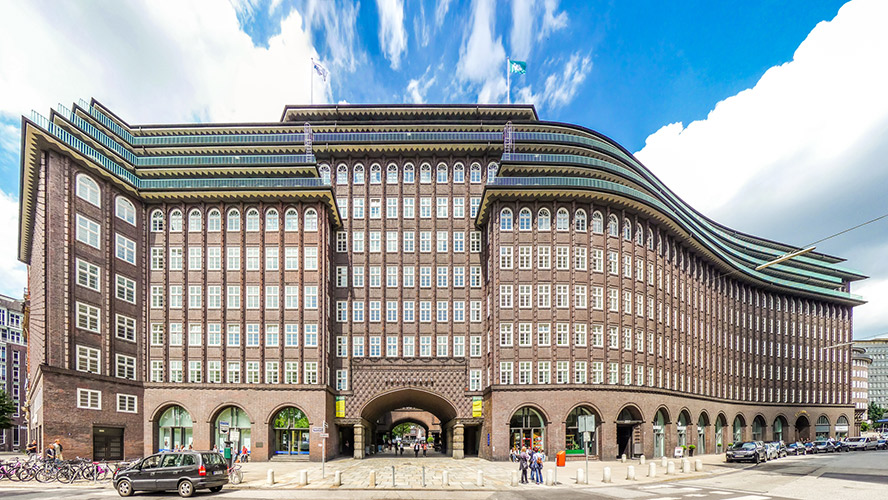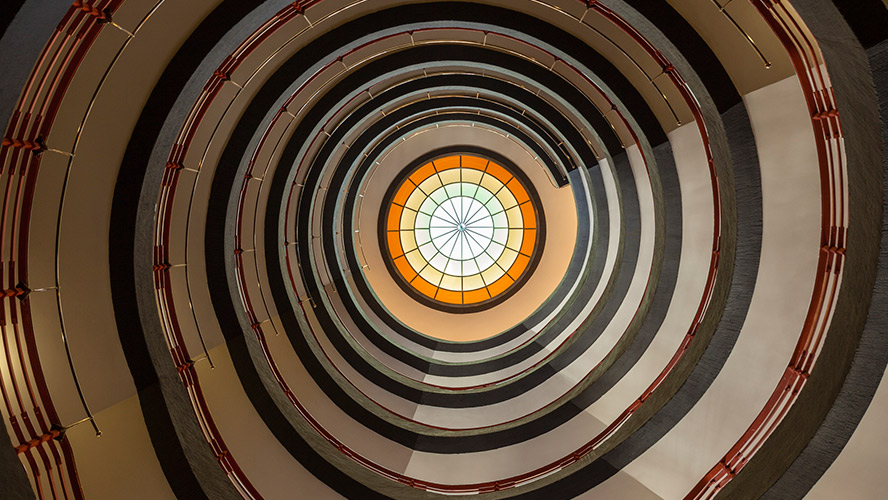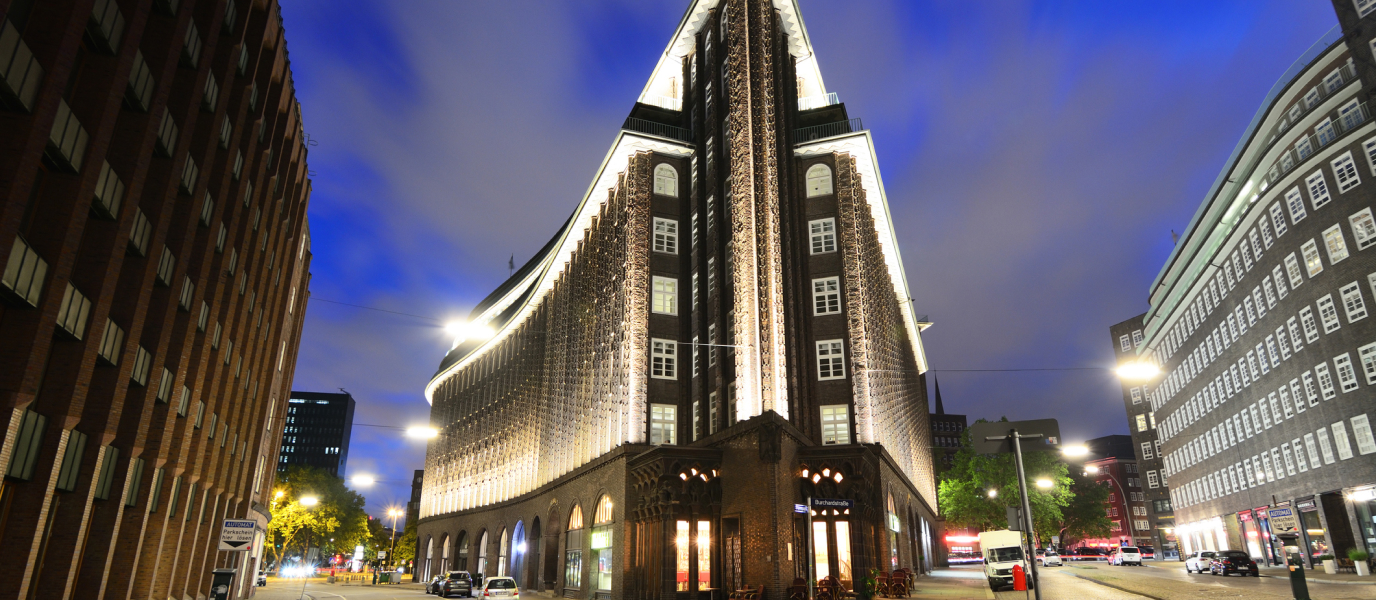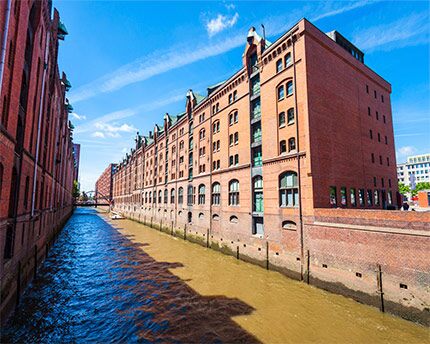While other cities have demolished their old port buildings and other industrial architecture, Hamburg has performed exceptional work to conserve and restore its port areas and they have been made a UNESCO World Heritage Site.
The Speicherstadt and Kontorhaus neighbourhoods are an excellent example of this restoration work, and the Chilehaus [Chile House] is the finest of all; this spectacular and impressive building shaped like a ship’s prow is an icon of Hamburg and German Expressionist architecture.
The Chilehaus is an office block that was built between 1922 and 1924 in the Brick Expressionist style, an architectural style that is typical to northern Germany.
History and origin of the building
The Chilehaus building was designed by architect Fritz Höger. It was named the “Chile House” because of Henry B Sloman, who commissioned the building. Sloman was a British businessman who had settled in Hamburg and made his fortune importing saltpetre from Chile at the beginning of the 20th century.
Amazingly, it was undamaged during the Second World War, when much of Hamburg was razed to the ground.
In 1983, the building was made a Historic Monument; in 1999 it became a UNESCO World Heritage Site candidate and was listed as a Site in 2015.
It’s still used as an office building today and is also home to the Instituto Cervantes in Hamburg.

Description and architectural style
As mentioned earlier, the Chilehaus was built in the Brick Expressionist style. The most characteristic features of this style are the use of dark coloured clinker brick, copper roofs and sharp, pointed angles, reflecting the tense atmosphere of the age. Despite the sober brickwork, these buildings still have attractive façades and other areas thanks to the use of decorative features.
This is the case at the Chilehaus, while its distinctive pointed corner is reminiscent of a ship’s prow. Fritz Höger wanted the Chilehaus to be the most important project of his career and an icon of the new city of Hamburg, which was being rebuilt after the First World War.

Several challenges arose during its construction due to its proximity to the Elba River and the soft subsoil; 16-metre-deep concrete pilings were installed, and the basement floors were sealed to prevent potential damage from flooding.
The building has 10 floors, used around 5 million bricks and was constructed by 4,000 workers. It has a reinforced concrete frame under the bricks and has the appearance of a city monument. The building covers a surface area of 36,000 m2.
Architect Fritz Höger earned great acclaim for the Chilehaus and won many new commissions afterwards, including the nearby Sprinkenhof.
What to see near the Chilehaus
The Chilehaus is in Kontorhaus neighbourhood, south of Hamburg’s old town. The area has several characteristic canals that were used by the old free port and several Expressionist buildings that are similar in style to the Chilehaus.
Buildings of interest near the Chilehaus include the Sprinkenhof (by the same architect), the Miramarhaus (the first building in Kontorhaus neighbourhood), the Montanhof and the Helmut-Schmidt-Haus. They’re all great opportunities to admire northern Germany’s Brick Expressionist style.
We also highly recommend walking around the neighbouring Speicherstadt area, the complex of old port warehouses that make up the World Heritage Site together with Kontorhaus.
There are also other places of interest in the area, such as Miniatur Wunderland, a miniature museum that is probably Hamburg’s main tourist attraction. It contains over 1,000 miniature trains, and the largest model railway in the world.
Hamburg’s International Maritime Museum is in another typical red brick building; this private collection contains thousands of photos and objects, including parts of shipyards, nautical maps and model boats.
And, while you’re in the heart of the port area, why not stop at the German Customs Museum? It’s full of countless curiosities: not only does it cover the history of customs, but it also recounts fun stories about concealed products that customs officers successfully detected, such as cocaine packed inside empty hazelnuts, cigarettes hidden inside footballs and diamonds packed into matchboxes.

Strolling around Speicherstadt and Kontorhaus makes for a spectacular walk, but make sure you also visit the rest of Hamburg and see the Town Hall, Fischmarkt and St Pauli neighbourhood.
Where to stay in Hamburg
Hamburg is a great city to explore on foot. Its wide streets, old port canals and fun atmosphere make it a wonderful destination for a city break.
Make sure you stay in the centre of Hamburg and enjoy all the advantages of a well-located hotel. The Barceló Hamburg is the perfect option because it’s right in the centre, just moments from Alster Lake, the Kunsthalle and the train station.
This four-star hotel has 193 modern rooms with the B-room concept, including several deluxe rooms and suites with balconies and city views. The hotel also has an à la carte restaurant with a terrace, a gym, and rooms for meetings and events.













































































